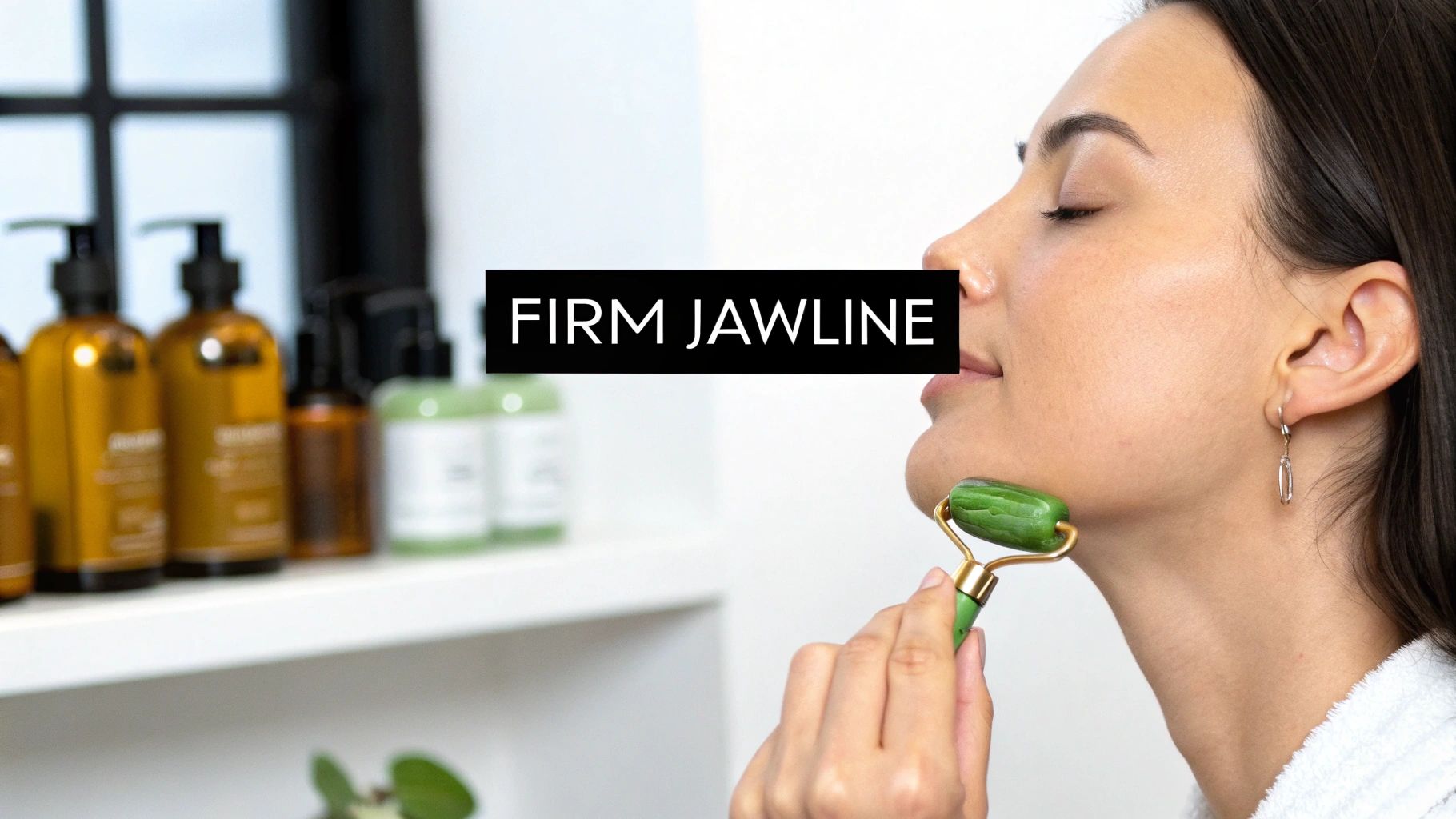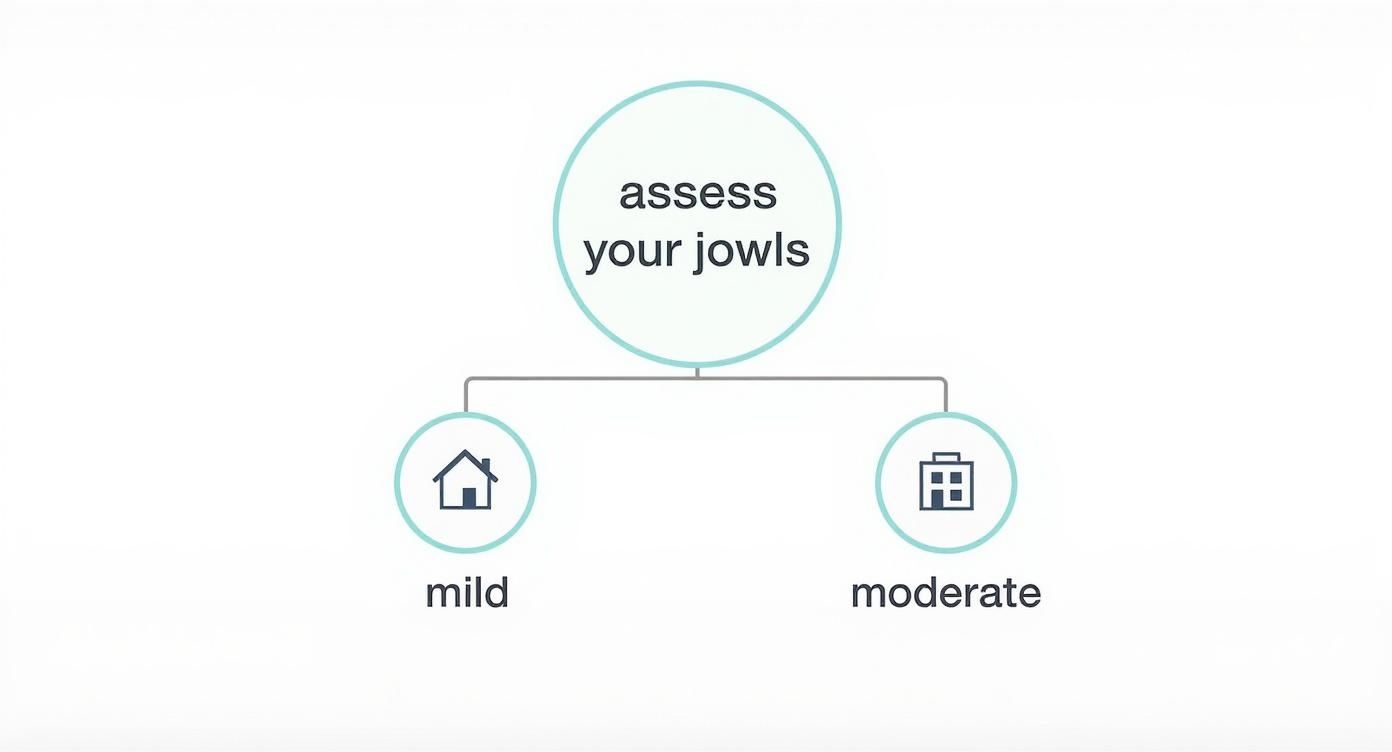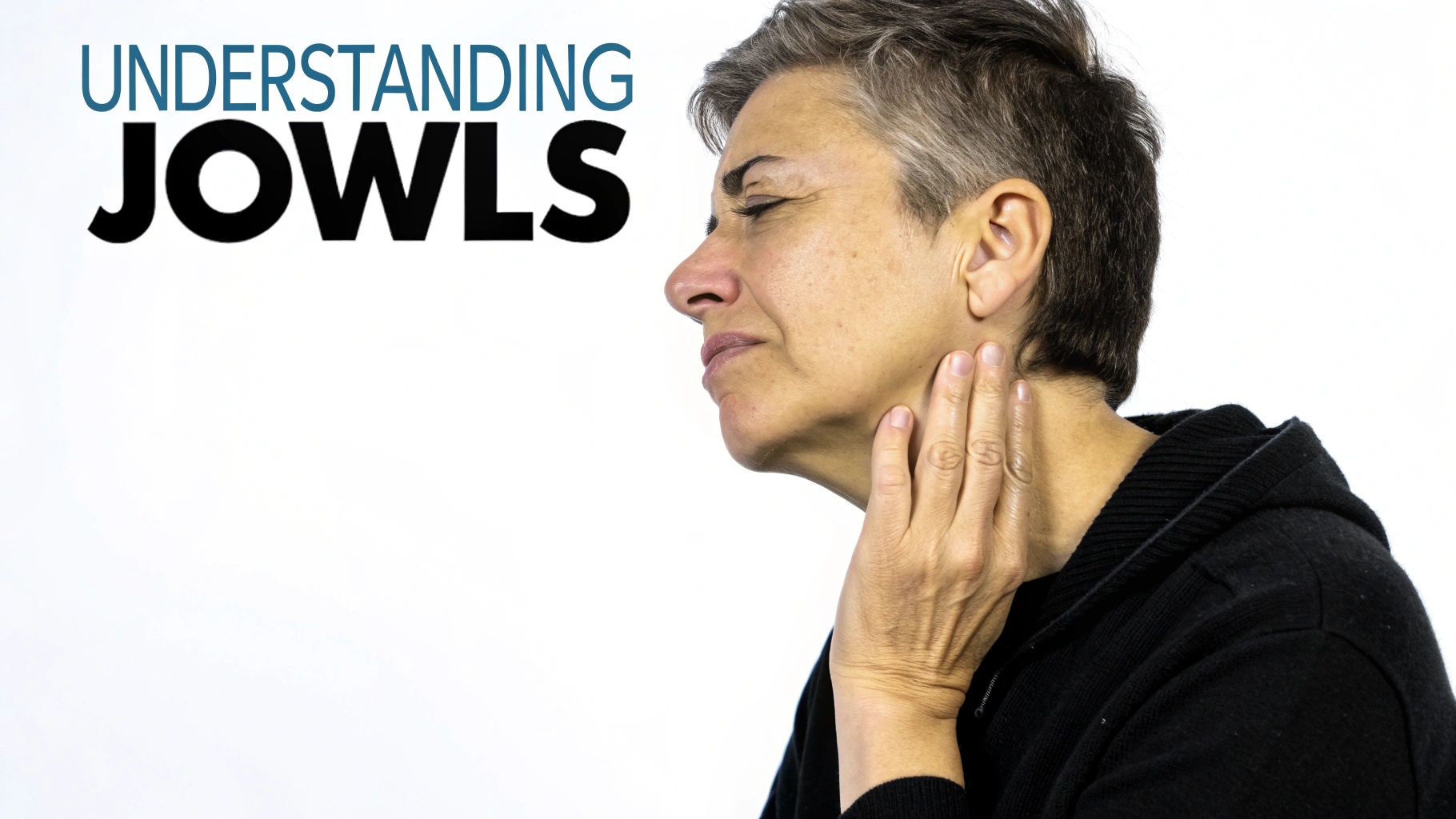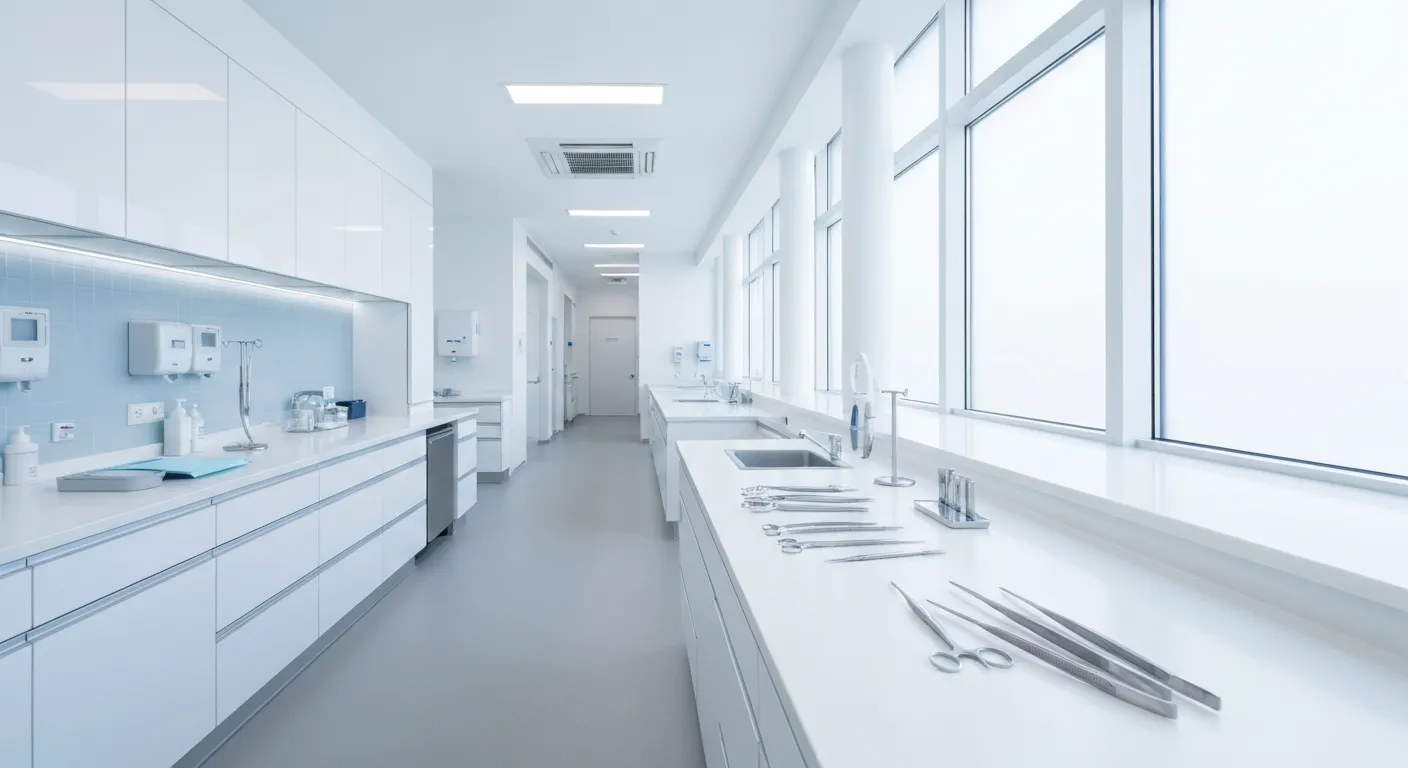
November 26, 2025
How to Get Rid of Jowls Without Surgery: A Practical Guide
Learn how to get rid of jowls without surgery with natural treatments, exercises, and skincare tips that actually work.
Nov 26, 2025

You absolutely can get a handle on jowls without going under the knife. The most effective strategies usually blend powerful at-home routines with professional, non-invasive treatments. Think of it as a one-two punch: you use targeted skincare and facial exercises at home, while clinical options like dermal fillers, radiofrequency (RF) skin tightening, or ultrasound therapy work on rebuilding collagen to redefine that jawline.
Before diving into treatments, let's get on the same page about what we're dealing with. Jowls are simply sagging skin below your chin or jawline. It’s a classic sign of aging, happening when your skin starts to lose its structural proteins—namely, collagen and elastin. Gravity, your genetics, and even lifestyle choices like sun exposure all team up to accelerate this process.
This loss of support makes the skin less firm, causing the drooping that we all recognize as jowls. It's an incredibly common concern, but the great news is that cosmetic dermatology has come a long way. There are now plenty of effective paths to a firmer jawline that don’t require a single incision. The spectrum of solutions is broad, which means there's likely a perfect fit for your level of sagging and personal goals.
The desire for non-surgical facial rejuvenation has exploded as more people look for real results with minimal downtime. It's a huge market—projected to hit $15.6 billion by 2027—which speaks volumes about its popularity and success. This shift is all about getting natural-looking outcomes with procedures that can fit into a busy life. You can read more about the growth of non-surgical cosmetic procedures and see just how far the technology has come.
Your journey starts with a realistic look at where your skin is today. The available non-surgical treatments generally fall into two camps:
Key Takeaway: The best non-surgical plans almost always combine consistent at-home care with professional treatments. This dual approach tackles both the skin's surface texture and its deeper structural support.
To give you a clearer picture, I've put together a quick comparison of the main non-surgical options.
This table helps you see how each treatment works and who it's best for, making it easier to pinpoint what might work for you.
This visual decision tree can also help you see how different levels of sagging might point you toward at-home care versus a clinical treatment path.

As the flowchart shows, milder concerns can often be kept in check with a dedicated at-home routine. For more moderate jowls, though, you'll get the most bang for your buck from professional intervention. This roadmap is all about starting with the most appropriate and effective strategy for your unique situation.

While professional treatments can deliver impressive results, the real work in the fight against sagging jowls happens every single day at home. Think of your daily habits as your first—and most important—line of defense. This consistent effort is what shores up your skin's structure, tones the muscles underneath, and pushes back against the very factors that cause jowls in the first place.
Here’s an analogy I often use with clients: clinical procedures are like hiring a top-tier personal trainer for a few incredibly intense sessions. They get you results, fast. But your at-home routine? That's your daily diet and exercise plan that keeps the results going. Without it, even the most effective professional treatments won't last as long as they could.
Your bathroom counter can be a powerful arsenal, but only if you're strategic about the products you use. A generic moisturizer simply isn't going to make a dent in sagging skin. To see real change, you need to zero in on active ingredients that are scientifically proven to kickstart collagen production and improve skin elasticity.
These aren't just fancy-sounding chemicals; they actually send signals to your skin cells, telling them to act younger and ramp up the production of the very proteins that keep your skin firm and bouncy.
For some direct topical support, adding a quality collagen for face serum into your routine can give your skin an extra boost in elasticity and firmness, targeting the jowl area specifically.
It might sound a bit odd, but just like the muscles in your arms or legs, the muscles in your face and neck get stronger with exercise. Focusing on toning the platysma—that broad sheet of muscle running from your collarbone up to your jaw—can create a much stronger support system for the skin sitting on top of it.
Now, let's be realistic: facial exercises won't magically lift severe sagging overnight. But they are fantastic for improving muscle tone and, just as importantly, boosting circulation, which brings a fresh supply of oxygen and nutrients right to your skin cells.
A simple one I love is the "Ceiling Kiss." Just tilt your head back, look straight up, and pucker your lips like you're trying to kiss the ceiling. You should feel a pull in your neck. Hold it for five seconds, relax, and aim for 10-15 repetitions a day.
Facial massage is another great tool, especially with something like a gua sha stone. The goal here is twofold: you're encouraging lymphatic drainage to reduce any puffiness that makes jowls look worse, and you're increasing blood flow. Always remember to use a facial oil so the tool can glide easily, and use gentle but firm upward strokes from your chin along the jawline toward your ears.
Here’s a modern-day contributor to jowls that most people completely overlook: bad posture. I'm talking about "tech neck." That constant habit of looking down at our phones or laptops does more than just strain our backs; it shortens the neck muscles and literally encourages the skin to droop forward and down.
Over time, this chronic position puts a ton of gravitational stress on the delicate skin of your neck and jaw, weakening its structure. Making a few simple tweaks to your workspace and habits can have a surprisingly big impact.
Quick Posture Fixes to Try Today
When you bring all these pieces together—potent skincare, targeted exercises, and mindful posture—you create a powerful at-home foundation. This daily commitment is absolutely crucial for getting, and keeping, a firmer and more defined jawline.
When your at-home efforts need a serious boost, professional skin tightening treatments are the next logical step. These technologies aren't just working on the surface; they use sophisticated, energy-based devices to get deep beneath the skin and tackle laxity right where it starts. It’s a way of prompting your skin to heal and rebuild itself from the inside out.
Think of it as waking up your skin's own internal scaffolding. The devices deliver controlled, targeted heat deep into the dermal layers. This sends a signal to your body to get busy producing fresh, strong collagen and elastin fibers. This whole process is called neocollagenesis, and it’s the key to getting that naturally firm, lifted look that we lose over time.
One of the most powerful tools we have in this area is High-Intensity Focused Ultrasound (HIFU), which you’ve probably heard of by its most famous brand name, Ultherapy. What makes HIFU so effective is its ability to bypass the top layer of skin and deliver pinpoint energy to specific depths. It can actually reach the same foundational tissues a surgeon would address in a facelift.
This precision allows for a really targeted treatment. We can heat the tissue to the exact temperature needed to kickstart collagen production without affecting the surrounding areas. During a session, a handheld device is glided over the jawline, delivering focused ultrasound pulses. You’ll likely feel a deep warmth or maybe some tingling as the energy gets to work.
For a lot of people, just one HIFU session is enough to get the collagen-building process going. If someone has more significant laxity, a second treatment might be a good idea. The results don't happen overnight—they appear gradually over two to three months as your body does its work, which is why the final look is so natural. In fact, you can continue seeing improvements for up to six months.
Another fantastic approach is using Radiofrequency (RF) energy. RF treatments work a bit differently, using an electrical current to generate heat in the skin’s deeper layers. Just like with HIFU, this heat is what gets your body to produce more collagen and elastin, leading to smoother, tighter skin.

An even more advanced version of this is RF Microneedling. This treatment is a real powerhouse because it combines the benefits of both microneedling and radiofrequency. The device uses incredibly fine needles to create tiny, controlled micro-injuries in the skin, which on their own trigger a healing response. At the exact same time, it delivers RF energy through those needles directly into the dermis.
This one-two punch is amazing for not just tightening sagging skin but also for improving overall skin texture and tone. I usually recommend a series of three to four sessions, spaced about four to six weeks apart, for the best outcome. You'll start to see some changes within a few weeks, but the full tightening effect really shines through after about three months. Our guide to non-invasive skin tightening options goes into even more detail on how these work.
Expert Insight: The real beauty of these energy-based devices is that they work with your body. They're leveraging your own biological processes to get results. This means the improvement is genuinely yours, so you never have to worry about looking "overdone."
Knowing what the experience is like can make all the difference. Here’s a quick look at what you can generally expect when you come in for one of these treatments.
These treatments are backed by solid clinical results. One landmark study on Ultherapy, for example, found that 85% of patients saw a noticeable improvement in their jowls after three months. And these aren't fleeting results, either—70% of them still saw those improvements up to two years later, which really speaks to the long-term value of stimulating your body's own collagen.
At the end of the day, both HIFU and RF technologies are incredible non-surgical options for creating a sharper, more defined jawline. They've truly become a cornerstone of modern aesthetic medicine.
When you’re looking for a more noticeable, structural change without committing to surgery, injectables and thread lifts are your best friends. These treatments are a powerful middle ground, working on the underlying architecture of your face to rebuild support, lift sagging tissue, and even dissolve small pockets of fat that create jowls.
https://www.youtube.com/embed/eHkVF38INc8
Think of it like this: skin tightening devices send a message to your skin, telling it to rebuild collagen over time. Injectables and threads, on the other hand, provide the actual scaffolding and lift right now. A skilled injector uses these tools like a sculptor, strategically placing products not just to fill lines, but to restore the youthful contours gravity has been working against.
There’s a good reason dermal fillers are one of the go-to solutions for jowls. When injected with precision along the jawline and into the pre-jowl sulcus—that little hollow that forms right in front of the jowl—they act like internal tent poles, adding volume and structure exactly where you’ve lost it.
This isn’t about creating a puffy or overdone look. The goal is to use denser, hyaluronic acid-based fillers that closely mimic bone. By adding this support directly onto the mandible, we can effectively straighten and sharpen the jawline, which in turn pulls the sagging skin taut for a cleaner profile. It’s often called a “liquid facelift” for the subtle yet significant lift it provides.
For those who need a more direct, physical lift, PDO (polydioxanone) thread lifts are a fantastic option. These aren't new; they're made from the same medical-grade, absorbable sutures that have been used in surgery for decades. In aesthetics, we use a fine needle to place them just under the skin, where they can physically grab and hoist sagging tissue back into place.
The real magic of threads is their dual-action approach:
Essentially, you get an immediate "wow" from the physical lift and a lasting improvement from your body's own collagen production. It's a clever way to get the best of both worlds.
The procedure is done with local anesthesia, and while some initial swelling or bruising is normal, the recovery is usually quick. You can learn more by exploring our detailed overview of PDO thread lifts as a non-surgical lift option.
Sometimes, the issue isn't just sagging skin—it's small, stubborn pockets of fat along the jawline or under the chin. Even with great skin tone, this excess fat can obscure the jawline and create a heavier, droopy look.
This is where fat-dissolving injections containing deoxycholic acid come in. Deoxycholic acid is a molecule your body naturally produces to help break down and absorb dietary fat. When we inject it into targeted areas, it permanently destroys fat cells. It's an excellent way to fine-tune the contours of the lower face.
Often, the best results come from combining treatments. For example, a patient might start with skin tightening to address laxity, then use fat-dissolving injections to debulk the area, and finish with a touch of filler to sharpen the jawline. This kind of multi-pronged strategy addresses all the contributing factors for a truly customized outcome.
With several highly effective options available, it helps to see how they stack up against each other. Each one works differently and is suited for slightly different concerns.
Ultimately, understanding these differences helps you and your provider choose the perfect tool—or combination of tools—to redefine your jawline and achieve a natural, rejuvenated look.

Let's be perfectly clear: the success of any non-surgical jowl treatment comes down to the person holding the syringe or device. The technology or product is just a tool. True artistry lies in the provider's deep grasp of facial anatomy, their years of hands-on experience, and their keen aesthetic eye.
Choosing your expert isn't just a simple step; it's the most critical decision you'll make.
A great provider doesn't just perform a procedure. They start by carefully assessing your facial structure, listening to what you want to achieve, and then mapping out a plan that gets to the root cause of your jowls. This is custom work, plain and simple.
Before you even pick up the phone for a consultation, do a little digging. The world of aesthetics has a confusing array of titles and certifications, so you need to know what to look for to ensure you’re in safe hands.
Don't be shy about verifying these credentials. Any provider worth their salt will be completely transparent about their qualifications. For a deeper dive, our guide on finding a qualified plastic surgeon has some great tips.
Think of the consultation as an interview—you're the one in charge. This is your chance to assess their expertise, get a feel for their approach, and see if you click. A good provider will welcome your questions and give you straight, honest answers.
Walk in with a list so you don't forget anything important.
Pay attention to the vibe. Do you feel listened to and respected, or are you being pushed toward a certain treatment? Trust your instincts. The best patient-provider relationships are built on confidence and trust.
When you look at their photo gallery, look for results that are consistent and, most importantly, natural. The goal is to look like a refreshed, more vibrant version of yourself. The best work is often so subtle that people won't know what you did—only that you look fantastic.
When you start looking into non-surgical options for your jawline, the questions come thick and fast. It's completely normal. From how long the results will stick around to whether it's going to hurt, you need real answers to feel confident moving forward. Let's get into the most common questions I hear from clients every day.
Making a decision about your appearance is a big deal, and you deserve to have all the facts, laid out honestly. My goal is to help you match your expectations with what these amazing treatments can actually deliver.
This is usually the first thing people ask, and the honest answer is: it really depends on the treatment. How long you'll enjoy the results is directly connected to how each procedure works with your body's natural processes.
Think of it this way: dermal fillers, when placed skillfully along the jawline, can last anywhere from 12 to 24 months. The exact timeline depends on the type of filler we use and how quickly your own body metabolizes it.
Then you have treatments like Ultherapy or RF microneedling, which get your own body to produce more collagen. Since you're rebuilding your skin's foundational support system from the inside out, these results are incredibly durable, often lasting one to two years.
A PDO thread lift gives you that immediate "wow" factor, a visible lift that typically holds for about 12 to 18 months. As the threads safely dissolve, they’ve already done a second job: creating a new collagen network that helps keep your improved contour in place even longer.
One thing to remember is that no non-surgical treatment can stop the clock on aging. Think of it as a reset. To keep things looking great, consistent at-home care and following the recommended maintenance plan are key.
The fear of pain keeps a lot of people from taking the next step, but I can tell you that we go to great lengths to make sure you're comfortable. For the most part, the discomfort is very minimal and easily managed.
For treatments that might have a bit more sensation, like RF microneedling or a thread lift, we'll apply a powerful topical numbing cream long before we start. This makes a world of difference and ensures the experience is as comfortable as it can be.
You'll also find that many of the fillers we use for jawline contouring already have lidocaine mixed in, so the area gets numb as we work. Clients usually describe the feeling as a bit of warmth, a slight pressure, or maybe a tingling sensation—but not real pain. Any minor soreness you might feel afterward is typically gone in a day or two.
Not only can you, but we often recommend it! A combination approach is frequently the secret to getting the most natural and impressive outcome. Jowls aren’t usually caused by just one thing—it’s often a mix of sagging skin, lost volume, and even muscles in the neck pulling things down. A multi-pronged strategy lets us address all of it.
A customized treatment plan might look something like this:
By layering treatments this way, we can tackle every factor contributing to jowls, creating a much more balanced and beautiful result.
Non-surgical options are fantastic for mild to moderate jowling. They work wonders for so many people. But there comes a point where the amount of sagging skin is just too much for non-invasive methods to handle effectively.
If you have significant skin laxity, a surgical facelift or neck lift is likely going to give you the most effective, long-lasting solution. Surgery allows a plastic surgeon to physically remove the excess skin and tighten the underlying muscle structure, which delivers a much more dramatic transformation.
The only way to know for sure which path is right for you is to sit down for a consultation. A board-certified dermatologist or plastic surgeon can properly assess your facial anatomy, listen to your goals, and help you decide on the best plan of action.
At Cape Cod Plastic Surgery, Dr. Fater and his team are dedicated to providing personalized consultations to help you understand all your options. To explore a treatment plan designed just for you, schedule your appointment at https://ccplasticsurgery.com.

November 26, 2025
Learn how to get rid of jowls without surgery with natural treatments, exercises, and skincare tips that actually work.

November 25, 2025
how much botox costs explained: learn what affects pricing, average ranges, and tips to save on your treatment.

November 25, 2025
Understanding Key Insights and Facts About Plastic Surgery